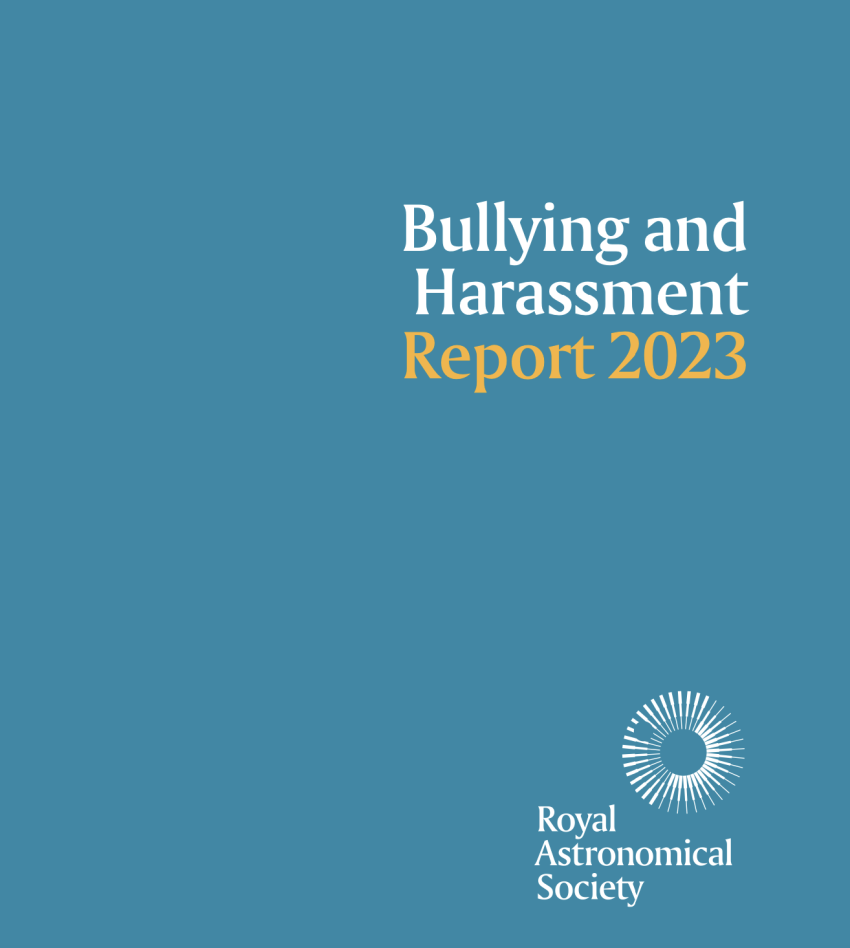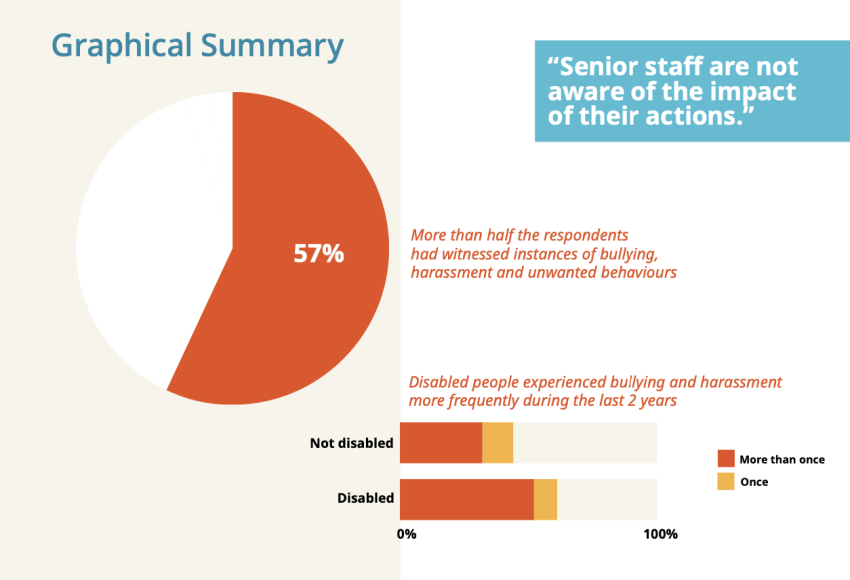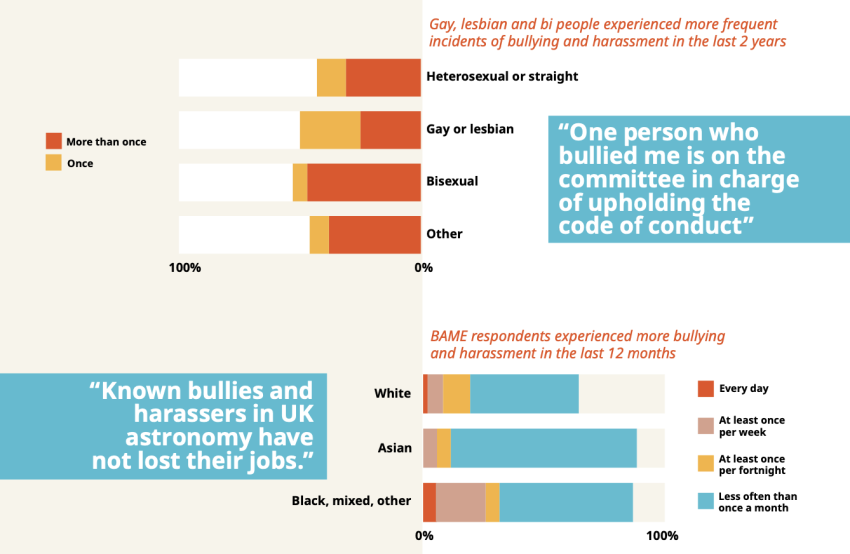“Urgent” action is needed to address an “insidious” and systemic bullying problem within the world of astronomy and geophysics, a damning new report warns.
The Royal Astronomical Society (RAS) has today published a list of recommendations to tackle the issue, after finding that such coercive behaviour and harassment is rife within the two sciences.
A survey commissioned by the Society showed that disabled people, women, Black and minority ethnic, and LGBTQ+ people are much more likely to be bullied and harassed than men and White, straight, and non-disabled people.
It also found that two-thirds (65 per cent) of respondents who reported complaints felt their concerns had been handled inadequately.
Among the key findings of the “stark” report were:
- Disabled, and Black and minority ethnic astronomers and geophysicists are 40 per cent more likely to be bullied than their non-disabled and White colleagues.
- Women and non-binary people in the field are 50 per cent more likely than men to be bullied and harassed.
- 50 per cent of lesbian, gay, bisexual, and queer astronomers and geophysicists were bullied in the 24 months preceding the survey, and 12 per cent of bisexual astronomers reported being bullied at least once a week.
- Those at more precarious stages in their careers, for example students and those on temporary contracts, are more likely to be bullied and harassed.
In response, the RAS is calling for the introduction of more effective bullying and harassment policies, procedures and safeguards to protect all colleagues, to support students, and to ensure that everyone can achieve their potential and work in a safe and satisfying environment, regardless of their background.
The Society’s proposals focus on three critical areas: prevention, reporting and accountability.
A detailed list of recommendations for individuals, managers, workplaces and organisations are available in the report. They include the need for better support to enable individuals to act, report, or disclose when harm is done, along with clear and transparent procedures for the reporting of complaints.
The RAS hopes that by enacting these recommendations - including actions for the Society itself - the fields of astronomy and geophysics can make headway towards becoming a safer and more inclusive workplace.
The RAS Committee on Diversity in Astronomy and Geophysics commissioned the survey, which was then carried out by the Society’s education, outreach and diversity officer Dr Sheila Kanani and then RAS diversity officer Dr Aine O’Brien.
Prior to this study no data capturing the extent of bullying and harassment among astronomers and geophysicists had been collected.
“The report release is a stark and timely reminder of the bullying and harassment issues we have in our sector, and wider,” said Dr Kanani.
“It is good to have baseline data to provide evidence behind the work that we’re doing. What followed from the data analysis is a set of recommendations for individuals, organisations and universities. This is where the work really starts!
"We are hoping that universities will sign up to our recommendations in due course. In addition to these recommendations, we have also published a set of actions for the RAS, to demonstrate our commitment to making our sector a better place, for our staff, Fellows and colleagues.”
RAS president Professor Mike Lockwood said: “The evidence in this report is a wake-up call to everyone in the world of astronomy and geophysics.
“The first step to solving any problem is to admit that there is one, and to gather evidence about the scale and nature of it. Now we have done that, it is clear the issue is both insidious and systemic.
“It requires urgent cultural change among organisations, institutions and individuals themselves to address what is currently an unacceptable situation.”
Former RAS president Professor Emma Bunce, who was instrumental in the survey, added: “The results presented in this report are bleak; they form a powerful case for change.
“The RAS is committed to supporting our community, and we strongly support further investigation of this issue across the broader science sector and the implementation of workplace policies and procedures that deliver positive change.”
The aims of the Bullying and Harassment report were to:
• Capture the experiences and perspectives of the astronomy and geophysics community regarding bullying and harassment, workplace culture and policies;
• Understand which communities are most likely to be adversely/disproportionately affected by these issues;
• Generate a robust dataset as a starting point and baseline for change in the fields.
The survey, which was carried out in 2020, revealed that 44 per cent of the 661 respondents worldwide had suffered some form of bullying and harassment in the workplace within the preceding 24 months.
It also showed that there was not a single demographic group, career stage or career path that had not experienced some form of bullying and harassment in the workplace.
However, there were multiple marginalised communities that stood out as having suffered far more than their colleagues.
Women and non-binary respondents were much more likely to be bullied than men, with 61 per cent of non-binary and other gender respondents and 59 per cent of women reporting being bullied and harassed, compared to 33 per cent of men.
The findings suggest that the efforts of the many woman-focused initiatives in astronomy and geophysics - such as the International Astronomical Union’s Women and Girls in Astronomy Project, and the dedicated awards for women in our field, including the RAS’s Caroline Herschel Medal - are offset by huge additional workplace hardships that many women face.
It also highlights that these initiatives do not represent non-binary and gender-fluid colleagues.
The report found that respondents with disabilities were 40 per cent more likely to be bullied and harassed in the workplace than their colleagues without disabilities.
In the two years prior to the survey, 61 per cent of respondents with disabilities suffered bullying and harassment, compared to 44 per cent of respondents without disabilities.
The report also suggests that LGBTQ+ astronomers and geophysicists are more likely to be bullied in the workplace than their straight/heterosexual counterparts, with 50 per cent of gay or lesbian respondents bullied in the two years prior to the survey, and 53 per cent of bi respondents, compared to 43 per cent of straight respondents.
In addition, the survey found that LGBTQ+ respondents suffered bullying and harassment more often, with 12 per cent of bi respondents bullied at least once per week, compared to 4 per cent of heterosexual/straight respondents.
It is not possible to say whether this bullying was targeted at their sexuality, however, because those who took part in the survey were not asked the nature of the bullying and harassment they suffered.
The report also suggests that Black, Asian and minority ethnic astronomers and geophysicists are more likely to be bullied and harassed than their white peers, with 50 per cent of Asian respondents and 51 per cent of Black, mixed and other heritage respondents reporting being bullied in the two years prior to the survey, compared to 43 per cent of white respondents.
Black, mixed and other heritage respondents were also more likely to suffer frequent bullying and harassment. Fourteen per cent of these respondents said they had experienced some form of abuse at least once per week, and an additional 3 per cent every day.
This compared to 4 per cent and 1 per cent of white respondents.
Not only is bullying and harassment systemic and endemic within the sciences of astronomy and geophysics, however, it is also not being tackled effectively, according to the report.
A third of those surveyed said they did not believe their employer took sufficient action to prevent bullying and harassment or unwanted behaviours at work.
They cited unclear reporting procedures, said supervisor relationships made whistleblowing difficult, and added that those in positions of power and influence are perceived as “invincible” and not punished.
The RAS recognises its role in advocating for equal access to astronomy and geophysics for all, but cannot directly change the policies and procedures of workplaces and organisations in the field.
However, the Society hopes that by giving a voice to the experiences of Fellows and colleagues that universities, research councils and other workplaces in the sector will improve their working practices as a result.
Media contacts
Sam Tonkin
Royal Astronomical Society
Robert Massey
Royal Astronomical Society
Images and captions
Caption: The Royal Astronomical Society has today published a list of recommendations after commissioning a report (pictured) which discovered that bullying and harassment is systemic within the fields of astronomy and geophysics.
Credit: Royal Astronomical Society
Bullying and harassment graphic 1
Caption: These graphics illustrate how more than half of respondents said they had witnessed instances of bullying and harassment, while disabled people experienced more of this unwanted behaviour than non-disabled people.
Credit: Royal Astronomical Society
Bullying and harassment graphic 2
Caption: These graphics show that gay, lesbian and bi people experienced more bullying and harassment than straight people, while BAME respondents also suffered more of this unwanted behaviour than their White peers.
Credit: Royal Astronomical Society
Further information
The report is available via the following link: https://ras.ac.uk/sites/default/files/2024-05/Final RAS Bullying and Harassment Report_digital_2024.pdf
Notes for editors
About the Royal Astronomical Society
The Royal Astronomical Society (RAS), founded in 1820, encourages and promotes the study of astronomy, solar-system science, geophysics and closely related branches of science.
The RAS organises scientific meetings, publishes international research and review journals, recognises outstanding achievements by the award of medals and prizes, maintains an extensive library, supports education through grants and outreach activities and represents UK astronomy nationally and internationally. Its more than 4,000 members (Fellows), a third based overseas, include scientific researchers in universities, observatories and laboratories as well as historians of astronomy and others.
The RAS accepts papers for its journals based on the principle of peer review, in which fellow experts on the editorial boards accept the paper as worth considering. The Society issues press releases based on a similar principle, but the organisations and scientists concerned have overall responsibility for their content.




